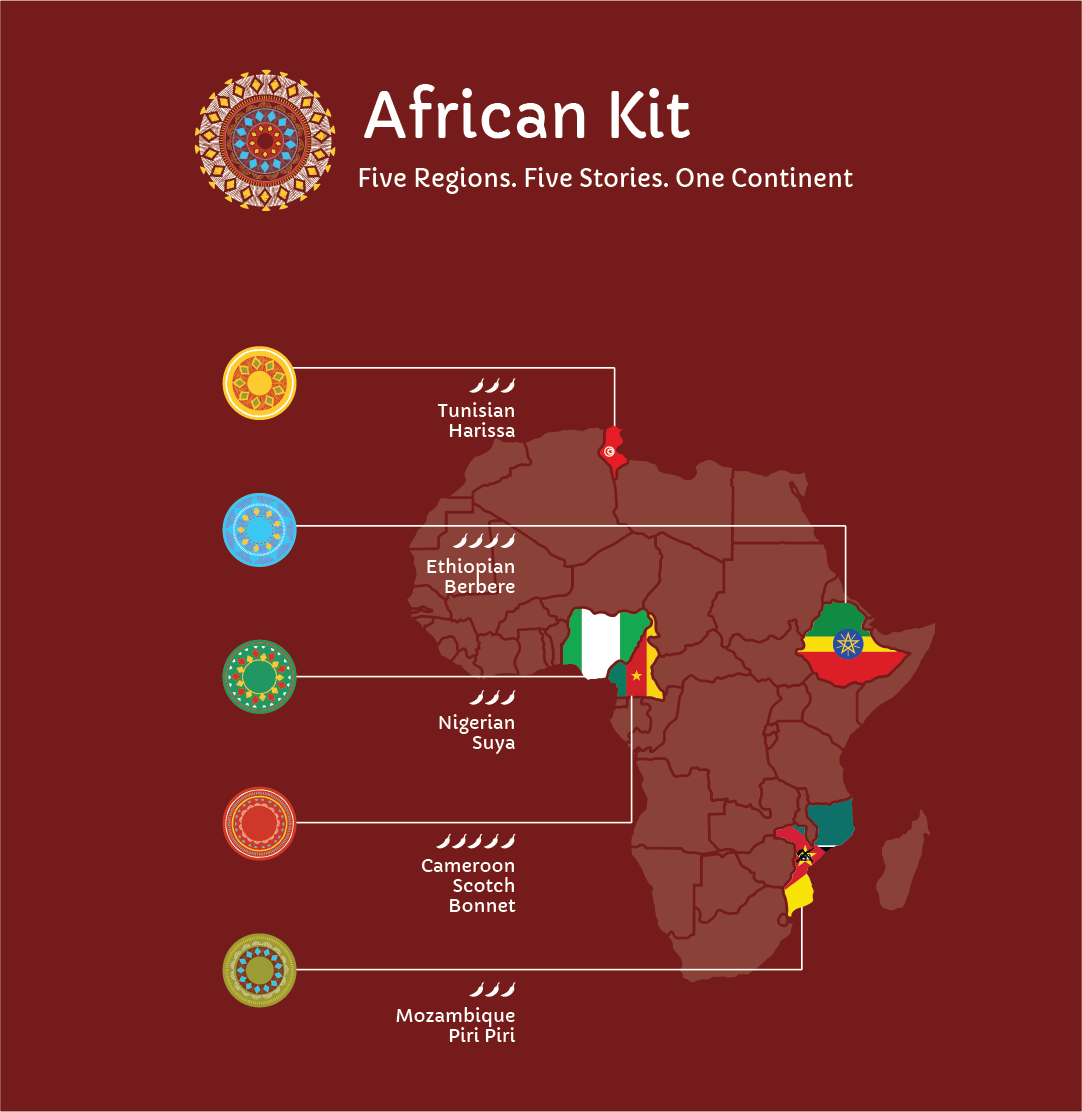-
🔥 Low Heat 🔥

-
🔥 Low Heat 🔥

-
🔥 Low Heat 🔥

-
🔥 Low Heat 🔥

-
🔥 Low Heat 🔥

-
🔥 Low Heat 🔥

-
🔥 Low Heat 🔥

SpiceQuest
African Spice Kit (5 Grinders + 5 African Spices)
African Spice Kit (5 Grinders + 5 African Spices)
Couldn't load pickup availability
Five Regions. Five Stories. One Continent of Flavor.
The SpiceQuest African Kit takes you on a journey across the continent, from the smoky souks of Tunisia to the street markets of Nigeria, the highlands of Ethiopia, and the coasts of Mozambique.
Each grinder holds a dry spice or blend sourced or inspired by its native region, curated for both its flavor and story. These are not extreme-heat peppers; they are flavor-forward spices designed to let you taste the character of each place, not just its fire.
Every spice is dried and flaked or powdered to preserve its aroma and integrity, then sealed in a push-button grinder for precise control. You don’t scoop, pour, or guess; instead, you grind to taste.
What's Inside
The SpiceQuest African Kit features five authentic African spices, each representing a region and a story. All are dry flakes or powders, designed to be ground fresh from your grinder to unlock true flavor and aroma.
1. Tunisian Harissa (North Africa)
A dry blend of sun-dried chili, garlic, caraway, coriander, cumin, and salt — the flavor base behind Tunisia’s iconic harissa.
Flavor: Smoky, garlicky, and warmly spiced with mild heat and deep earthiness.
🇹🇳 Discover its origins, recipes, and more.
2. Ethiopian Berbere (East Africa)
A complex dry blend of chili, garlic, ginger, fenugreek, basil, and warming spices.
Flavor: Earthy, aromatic, and slightly sweet with a medium, slow-building heat.
🇪🇹 Discover its origins, recipes, and more.
3. Nigerian Suya (West Africa)
A nutty, smoky dry rub made from ground peanuts, chili, garlic, ginger, onion, and paprika.
Flavor: Savory, rich, and bold with a touch of smoke and medium-hot heat.
Contains peanuts.
🇳🇬 Discover its origins, recipes, and more.
4. Cameroon Scotch Bonnet (Central Africa)
Pure dried and crushed Scotch Bonnet chili, known locally as Cameroon pepper.
Flavor: Fruity, citrusy, and vibrant with very high heat that’s full of character, not just fire.
Discover its origins, recipes, and more.
5. Mozambican Piri Piri (Southern Africa)
Dried African bird’s eye chili blended with garlic, lemon zest, and salt — the heart of Mozambique’s coastal cooking.
Flavor: Zesty, tangy, and bright with a clean, citrus-forward heat.
Discover its origins, recipes, and more.
Note:
- All spices are 100% dry flakes or powders, ready to grind fresh for flavor control.
- Heat levels range from mild to medium/hot. Start light and adjust to taste.
- Produced in a facility that also handles peanuts, tree nuts, and sesame.
How It Works
Each spice comes in its own push-button grinder for fresh flavor at every meal.
- Grind directly onto food: no measuring spoons, no mess.
- Taste before you commit: start light and build flavor your way.
- Experiment: same roasted veggies, five different flavor journeys.
Why We Made It
SpiceQuest was built to give people control over heat and flavor and to transform how we experience spice.
The African Kit celebrates a continent that gave the world some of its boldest and most diverse seasonings. From the communal grills of Lagos to the slow stews of Addis Ababa, these spices carry history, culture, and the art of balance. These are flavors that excite, not overwhelm.
Each kit includes:
- Five individually labeled grinders
- Region map & cultural guide insert
- QR access to recipes, videos, and music from each region
Flavor Over Fire
Yes, there’s heat, but these are not “challenge” peppers. Each grinder is curated for its distinctive flavor: sweet-smoky, citrusy, nutty, or herbal. You’ll experience heat as a supporting note, not the whole story.
This kit is for explorers of taste — those who want to understand why peppers from different regions taste different, and how heat can become an art form.
The SpiceQuest Promise
Every kit is designed and hand-assembled in California, with careful sourcing and storytelling at its core. Each spice is tested, graded, and matched to its cultural origin — because every grind should tell a story.
Share














